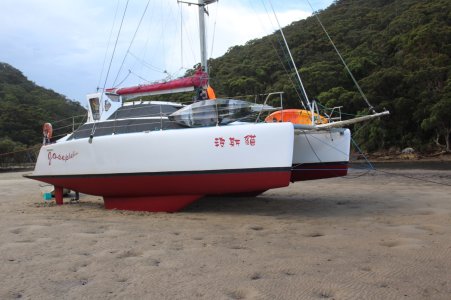thinwater
Well-known member
[This follows a post suggesting that the main effect of a slope is that it changes the rode angle at the bottom (see below image from that thread). Slope does change the rode angle and that does matter, but ... ]

This is an interesting topic, and I'm starting a new thread for it. When I started sailing, as a new engineer, I understood the above calculation (thanks Nolex), found it obvious and reassuring. Most sailors do. But after years of engineering and sailing, I think it sometimes simulates the situation, but I'm going to have to offer my apology for this. I think it misses the real point entirely and is most often not the most important factor. The important affect of slope is its affect on soil strength and characteristics.
The important questions are:
---
First, unless it is a severe slope (channel edge), the slope is typically quite small. Perhaps 3 feet in 200 feet, or 1.5%. At 5:1 scope this is less than 10% of the angle, and at 10: scope the chain is probably staying on the bottom (zero bottom angle) both ways. Not a zero effect, but minor.
Let's imagine an extreme case. First, a field of level fine gravel. Place an anchor at infinite scope and it digs. Then place the same anchor on the same gravel, but on a pile that is at its angle of repose (won't get steeper without sliding). Pull the anchor down slope with infinite scope, and it holds nothing at all. The gravel just slides. The rode angle did not change. The material did not change. But the down slope holding is nothing, no matter how much scope. For the same reason you cannot climb up the pile. If you then drag the anchor uphill (same rode angle) you get a very different result. It holds. But it was not the rode angle that mattered.
Why is there a steep slope?
[Notice how smooth the proppant sand is at top. No sheer strength. Crappy for anchoring, but easy to pump down fraced wells.]

Coral sand. Not great because it is so light.

Angles make it strong. Good for foundations. Fine angular sand is the stuff anchors makers dream of.

So what if the slope has an angle of 1:30 and the angle of repose of such sand is 1:20? The slope is not geometrically important, but the slope is close to landslide geometry and can hold very little without sheering out.
I don't think it is the maths of a slope and rode angle. I think it is
This is an interesting topic, and I'm starting a new thread for it. When I started sailing, as a new engineer, I understood the above calculation (thanks Nolex), found it obvious and reassuring. Most sailors do. But after years of engineering and sailing, I think it sometimes simulates the situation, but I'm going to have to offer my apology for this. I think it misses the real point entirely and is most often not the most important factor. The important affect of slope is its affect on soil strength and characteristics.
The important questions are:
- why the slope exists
- the slope's affect on soil shear strength
---
First, unless it is a severe slope (channel edge), the slope is typically quite small. Perhaps 3 feet in 200 feet, or 1.5%. At 5:1 scope this is less than 10% of the angle, and at 10: scope the chain is probably staying on the bottom (zero bottom angle) both ways. Not a zero effect, but minor.
Let's imagine an extreme case. First, a field of level fine gravel. Place an anchor at infinite scope and it digs. Then place the same anchor on the same gravel, but on a pile that is at its angle of repose (won't get steeper without sliding). Pull the anchor down slope with infinite scope, and it holds nothing at all. The gravel just slides. The rode angle did not change. The material did not change. But the down slope holding is nothing, no matter how much scope. For the same reason you cannot climb up the pile. If you then drag the anchor uphill (same rode angle) you get a very different result. It holds. But it was not the rode angle that mattered.
Why is there a steep slope?
- Dredging nearby. Probably a bad place to anchor because of traffic.
- Strong tide. Often this makes the bottom very hard because anything loose has been scoured away. I know some slopes in the Chesapeake like this; good fishing but terrible anchoring. They're not even steep, just mudstone and super hard clay.
- Outflow "pile" from a river. The sediment may be fresh and poorly consolidated. It may also be near its angle of repose.
[Notice how smooth the proppant sand is at top. No sheer strength. Crappy for anchoring, but easy to pump down fraced wells.]
Coral sand. Not great because it is so light.

Angles make it strong. Good for foundations. Fine angular sand is the stuff anchors makers dream of.
So what if the slope has an angle of 1:30 and the angle of repose of such sand is 1:20? The slope is not geometrically important, but the slope is close to landslide geometry and can hold very little without sheering out.
I don't think it is the maths of a slope and rode angle. I think it is
- Why the slope exists. Tidal souring or outflow.
- The type of soil, its angle of repose, and other soil strength factors.
Last edited:


